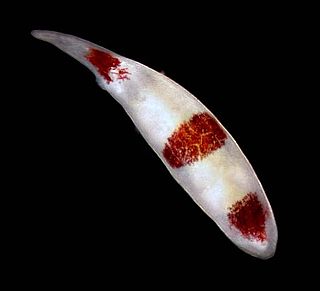
Acrossocheilus is a genus of ray-finned fishes in the family Cyprinidae, native to freshwater in China, Taiwan, Laos, and Vietnam. They are fairly small, no more than 30 cm (1 ft) in standard length.

The Prolecithophora are an order consisting of an estimated 300 species of small, active, aquatic flatworms. The order lacks a common English name. Most species are shaped like an elongated, stylized droplet, and are opaque white or yellow; they frequently have contrasting bands or spots in colors, such as purple, yellow, red, or brown. They have no to three pairs of pigment-cup eyes, and well-developed tactile and chemoreceptor senses. With few exceptions, species are protandric hermaphrodites with internal fertilization. Egg capsules are, according to species, glued to various hard surfaces; the young hatch as miniature copies of their parents.
Leptobotia is a genus of fish in the family Botiidae endemic to China.

Epipogium, commonly known as ghost orchids, is a genus of four species of terrestrial leafless orchids in the family Orchidaceae. Orchids in this genus have a fleshy, underground rhizome and a fleshy, hollow flowering stem with small, pale coloured, drooping, short-lived flowers with narrow sepals and petals. They are native to a region extending from tropical Africa to Europe, temperate and tropical Asia, Australia and some Pacific Islands.
Actinoposthiidae is a family of acoels.
Childia is a genus of acoels in the family Mecynostomidae.

Proporidae is a family of acoels.

Isodiametridae is a family of acoels.

Alphestes is a genus of marine ray-finned fish, groupers from the subfamily Epinephelinae in the family Serranidae, which also includes the anthias and the sea basses. Alphestes species are found in the western Atlantic Ocean and the eastern Pacific Ocean.
Microstomum is a genus of flatworms in the family Microstomidae.

Meara is a genus of bilaterally symmetric, small aquatic worms in the phylum Acoelomorpha. This genus contains only one species, Meara stichopi, a parasite of the sea cucumber Parastichopus tremulus. It occurs in Norway and Sweden.
Multipeniata is a genus of flatworms in the order Prolecithophora. It is the only genus in the monotypic family Multipeniatidae.
Kuma is a genus of acoels belonging to the family Proporidae.
Actinoposthia is a genus of acoels belonging to the family Actinoposthiidae.
Hallangia is a genus of acoels belonging to the family Hallangiidae.
Haplogonaria is a genus of acoels belonging to the family Proporidae.
Faerlea is a genus of acoels belonging to the family Isodiametridae.
Tetraposthia is a monotypic genus of acoels belonging to the family Actinoposthiidae. The only species is Tetraposthia colymbetes.
Intoshia is a genus of worms belonging to the family Rhopaluridae.
Nemertoderma is a genus of acoelomorphs belonging to the family Nemertodermatidae.






